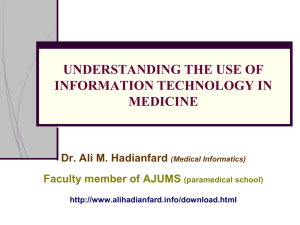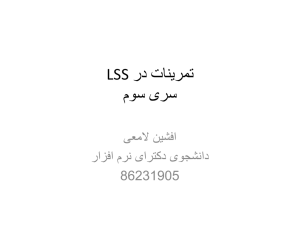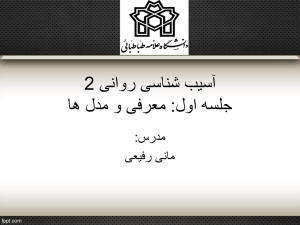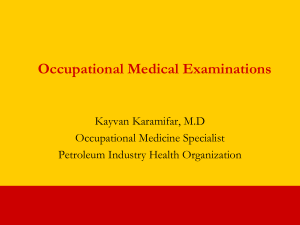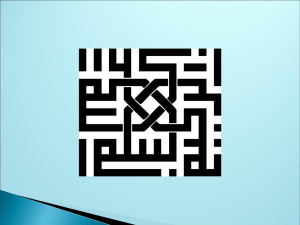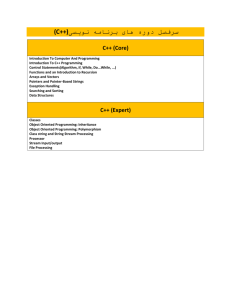Understanding the use of information technology in medicine
advertisement
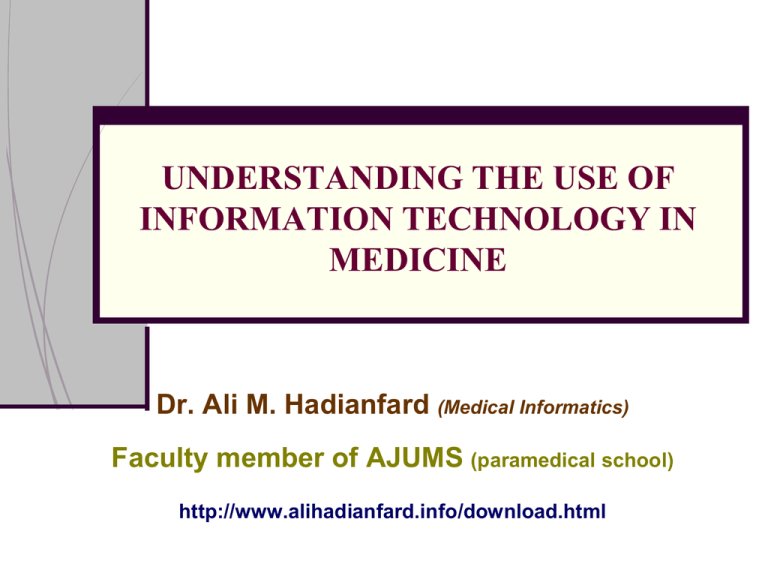
UNDERSTANDING THE USE OF INFORMATION TECHNOLOGY IN MEDICINE Dr. Ali M. Hadianfard (Medical Informatics) Faculty member of AJUMS (paramedical school) http://www.alihadianfard.info/download.html FURTHER READING www.alihadianfard.info − Information Technology for health professions, Lillian Burke & Barbara Weill (whole book). − E-Health Care Information Systems, Joseph Tan, 2005 (chapter 16). 2 مزایایی استفاده از تکنولوژی اطالعات در پزشکی دسترس ی به اطالعات بیمار بطور همزمان و از راه دور بهبود آموزش و تحقیقات منطقی نمودن هزینه های خدمات مراقبتی 3 www.alihadianfard.info ارائه خدمات مراقبتی با کیفیت ،سهولت و سرعت بیشتر Example 1: Hardware used in medicine Personal Digital Assistants (PDAs): Originally could hold only a notepad, a calendar, and an address book. www.alihadianfard.info These computers usually do not have keyboards but rely on touchscreen technology for input. Today, sophisticated PDAs are used throughout the health care system. Physicians can write prescriptions on PDAs, consult online databases, and capture patient information and download it to a hospital computer. PDAs also hold reference manuals and are used in public health to gather information and help track diseases and epidemics. 4 Example 2: Hardware used in medicine Cell phone: In places without electricity and without landlines, wireless networks using cell phones and PDAs are www.alihadianfard.info both bringing health information to people and gathering information to track the spread of disease. Using cell phones, pagers, and handheld devices to alert patients about doctor’s appointments, or remind patients of scheduled medication, vitamins or supplements, selfadministered blood sugar tests, walking and stretching exercises. The use of Global Positioning System (GPS) technology, which can pinpoint your location to within several feet, is widely available. 5 Example 3: Hardware used in medicine www.alihadianfard.info The embedded computer: is a single-purpose computer on a chip of silicon, which is embedded in anything from appliances to humans. An embedded computer may help run your car, microwave, pacemaker, or watch. A chip embedded in a human being can dispense medication, among other things. 6 Example 4: Hardware used in medicine Digital Camera: Vision input systems are currently being www.alihadianfard.info developed and refined. A computer uses a camera to digitize images and stores them. The computer “sees” by having the camera take a picture of an object. The digitized image of this object is then compared to images in storage. This technology can be used in adaptive devices, such as in glasses that help Alzheimer’s patients. The glasses include a database of names and faces; a camera sees a face, and if it “recognizes” the face, it gives the wearer the name of the subject. 7 Example 5: Hardware used in medicine Speech input systems: allow you to talk to your www.alihadianfard.info computer, and the computer processes the words as data and commands. A system geared toward medicine would include an extensive vocabulary of digitized medical terms and would allow the creation of patient records and medical reports. This system can be used as an input device by physicians who, in turn, can dictate notes, even while, for example, operating. Speech recognition is also especially beneficial as an enabling technology, allowing those who do not have the use of their hands to use 8 computers. Example 6: Hardware used in medicine Sensors: A sensor is a device that collects data www.alihadianfard.info directly from the environment and sends those data to a computer. Sensors are used to collect patient information for clinical monitoring systems, including physiological, arrhythmia, pulmonary, and obstetrical/ neonatal systems. In critical care units, monitoring systems make nurses aware of any change in a patient’s condition immediately. They detect the smallest change in temperature, blood pressure, respiration, or any other physiological measurement. 9 Example 7: Hardware used in medicine Human-biology input devices: allow you to use www.alihadianfard.info your body as an input device. Biometrics identify people by their body parts. Biometrics include fingerprints, hand prints, face recognition, and iris scans. For instance, Line-of-sight input allows the user to look at a keyboard displayed on a screen and indicate the character selected by looking at it. Implanted chips have allowed locked-in stroke patients to communicate with a computer by focusing brain waves (brain wave input). 10 Example 8: Hardware used in medicine Bluetooth: Bluetooth technology is used to create small www.alihadianfard.info personal area networks. Bluetooth is a wireless technology that can connect digital devices from computers to medical devices to cell phones. For example, if someone is wearing a pacemaker and has a heart attack, his or her cell phone could automatically dial 911. Wi-Fi: is a wireless technology that allows you to connect, for example, a PDA (and other devices) to a network (including the Internet) if you are close enough to a Wi-Fi access point. 11 Example 9: Hardware used in medicine Radio frequency identification (RFID) tags: is the wireless non-contact use of radio-frequency www.alihadianfard.info electromagnetic fields to transfer data, for the purposes of automatically identifying and tracking tags attached to objects. The tags contain electronically stored information e.g. medical history. Radio frequency identification (RFID) is part of the family of Automatic Small RFID chip, here compared to a grain of rice, is incorporated in consumer products, and implanted in pets, for identification purposes Identification and Data Capture (AIDC) technologies that includes 1D and 2D bar codes. It is now used to identify anything the surgeon left in your body. 12 Example 10: Hardware used in medicine Near Field Communication (NFC) technology: is a wireless communication standard which enables two devices in a short range to establish a communication channel within a short www.alihadianfard.info period of time (100-150 milliseconds) through radio waves in the 13.56 MHz frequency range. NFC can be a useful technology for data transfer between two devices (two-way connections) in close proximity to one another (less than 10 cm). it is more secure than other wireless technologies like Bluetooth and Wi-Fi. The biggest differentiating factor for NFC over RFID is that it is a two-way communication tool, one of the devices/cards can have a passive NFC tag. In particular Implantable Medical Devices (IMD) require privacy and security to reduce the third party interference and proper health maintenance. These features can effectively achieved by NFC compared with other wireless technologies. For example, using heart rate monitors 13 موارد کاربرد تکنولوژی اطالعات در پزشکی • کاربرد های مدیریتی) (Administrative Application؛ شامل استفاده از کامپیوتر در امور مربوط به اداره امور بیمار می باشد. که بطور مستقیم مربوط به مراقبت از بیمار می باشد نظیر خدمات تشخیص ی و درمانی. • کاربردهای اختصاص ی)(Special Purpose Application؛ شامل استفاده از کامپیوتر برای کاربرد های خاص مانند آموزش و تحقیقات می باشد. 14 www.alihadianfard.info • کاربردهای بالینی)(Clinical Application؛ شامل استفاده از کامپیوتر در خدماتی کاربرد های مدیریتی انجام امور اداری و دفتری نظیر ارسال و دریافت و آماده سازی نامه های الکترونیکی بیمه و دستمزد کارکنان ،گزارشات بستانکاری ادارات بیمه طرف قرارداد ،انبارداری و اموال مانند )EMC (electronic media claim نرم افزارهای پذیرش و ترخیص شامل تعیین وقت مالقات ،انتقال ،تهیه آمار ،کد گذاری 15 www.alihadianfard.info نرم افزارهای حسابداری شامل صورتحسابهای بیمار ،دریافتها ،پرداختها ،لیستهای www.alihadianfard.info Some definitions related to patients’ bill Charges, payments, and adjustments are called transactions. A charge is simply the amount a patient is billed for the provider’s service. A payment is made by a patient or an insurance carrier to the practice. An adjustment is a positive or negative change to a patient account. A claim is a request to an insurance company for payment for services. Medicaid is a health insurance for certain low-income and needy people. Medicare serves people aged 65 years and over and disabled people with chronic renal disorders. 16 INFORMATION TECHNOLOGY IN TELEMEDICINE Telemedicine uses computers and telecommunications equipment to deliver medical care at a distance. From plain old telephone service to the Internet. www.alihadianfard.info The medical information transmitted can be in any form including voice, data, still images, and video. Teleconferencing: videoconferencing, Tele-consulting, telecommunication, used in prison Telesurgery: robotic surgery Teleradiology: uses store and forward technology Telecardiology: heart and lung sound, chest pain, pacemaker Telepathology: microscopic images Telenursing: telehome cares, remote monitoring, recommendation, teletriage (the method of deciding who receives medical treatment first, according to how seriously someone is injured or needed). Remote Monitoring: used in ambulances, telehome cares Telepharmacy Teledentistry 17 STORE-AND-FORWARD TECHNOLOGY Store-and-forward (SAF) technology involves sharing information in a www.alihadianfard.info time- and place-independent way over the Internet. The information is stored, digitized, and then sent (Asynchronous). If a medical specialty is image based, store-and-forward technology may be appropriate. The information may include digital images and clinical information. It may be as simple and inexpensive as attaching an image to an e-mail and sending it over telephone lines. store-and-forward technology is cheap and does not require sophisticated equipment or broadband lines. The earliest use of store-and-forward technology was in teleradiology. It is appropriate to specialties where diagnosis is based on images, such as dermatology and pathology. 18 INTERACTIVE TECHNOLOGY Allows doctors to consult with each other and with patients in real- www.alihadianfard.info time (Synchronous), at a distance. A patient may be in his or her primary physician’s office with a camera and a telecommunications link to a specialist’s office. All can see and hear each other in real time. It might require only a video-phone and a connection to the Internet. However, the most sophisticated systems involve microphones, scanners, cameras, medical instruments, and dedicated telephone lines. One form of video-teleconferencing is the remote house call, involving only one medical practitioner and a patient in another location. 19 INFORMATION TECHNOLOGY IN RADIOLOGY Digital X-ray: less radiation, 3-D, quality is the same, Can be www.alihadianfard.info Manipulated and shared, more expensive Ultrasound: computer generates an image, producing a 2-D moving picture on a screen. Digital imaging: Computerized Tomography Scan, Magnetic Resonance Imaging, Positron Emission Tomography, Single Photon Emission Computer Tomography Interventional radiology (Bloodless Surgery) 20 مزایای کاربرد تصویر برداری پزشکی دیجیتالی ایجاد تصاویر شفاف تر ،درست تر و با جزئیات بیشتر از اندامهای داخلی ایجاد تصاویر سه بعدی کاهش نیاز به جراحیهای کاوشگرانه کاهش مدت اقامت در بیمارستان انجام اعمال جراحی دقیق تر و بهتر کمک به تشخیص بهتر بیماریهای مغزی 21 www.alihadianfard.info امکان تصویر برداری از بافتهای نرم و عملکردهای شیمیایی مغز INFORMATION TECHNOLOGY IN SURGERY Computer-Assisted Surgical Planning: Virtual environment, Virtual Reality (VR) Technology (is a computer-simulated environment that can simulate physical www.alihadianfard.info presence in places in the real world or imagined worlds. Virtual reality could recreate sensory experiences, including virtual taste, sight, smell, sound, touch, etc.). For example, VR Virtual Reality Pain Reduction software enables estimates of cancer invasion to surrounding organs based on virtual cancer images of individual patients. Minimally Invasive Surgery (MIS) Computer Assisted Surgery and Robotics Tele-presence Surgery Augmented Reality Surgery: . توسعه آنچه جراح می تواند ببیند، بعدی از تصاویر دوبعدی بوسیله کامپیوتر3 ساخت تصاویر مجازی 22 INFORMATION TECHNOLOGY IN DENTISTRY ⃰ ⃰ Intra oral Fiber Optic Camera: نمایش تصاویراز کانال ریشه و نمایش آن روی صفحه نمایش جهت دندانپزشک و بیمار ⃰ تهیه مدل تاج دندان با استفاده از نرم افزارهای کامپیوتری ⃰ ایجاد یک تصویر فرض ی از صورت بعد از عمل به منظور نمایش تغییرات ⃰ www.alihadianfard.info Cosmetic Dentistry: ⃰ Digital Radiography ⃰ Digital Imaging Fiber Optic Transillumination: the transmission of light through ⃰ tissues of the body ⃰ Surgery: Planning, Dental Implants Use of 3-D visualization tools coupled with interactive modeling (which allow the users to participate actively) allows dentists to better understand jaw articulation, while simulation of jaw movements helps dentists to deal with complex contact points and observe the actual functioning of the human jaws, thereby learning how to better treat their patients. 23 INFORMATION TECHNOLOGY IN PHARMACOLOGY از طریق ایجاد مدل های گرافیکی:استفاده از نرم افزار در کمک به طراحی و آزمایش داروهای جدید www.alihadianfard.info .سه بعدی از مولکول های هدف Computer- Assisted Drug Trials: To simulate Clinical Trials Computer- Assisted Drug Review and Approval Process The Computerized Pharmacy: Drug order, Patient’s Medication Profile Computer Warning and Drug Errors: Prescription errors (legible, dosage), Medication errors, Drug Interactions, Patient’s Allergies 24 INFORMATION TECHNOLOGY IN PHARMACOLOGY The Automated Community Pharmacy: use of Robotic systems www.alihadianfard.info and Bar cods Automating Drug Distribution Systems: similar to ATM machines Point of use drug dispensing: at the nursing unit Drug Delivery on a Chip: deliver several medication, deliver specific doses at predetermined times 25 INFORMATION TECHNOLOGY IN MEDICAL INSTRUMENTS Computerized Functional Electrical Stimulation: electrical www.alihadianfard.info stimulation to muscles Computerized Monitoring Systems: physiological monitoring systems, arrhythmia monitors, pulmonary monitors, fetal monitors, neonatal monitors Computerized Devices in Optometry / Ophthalmology : Corneal topography 26 INFORMATION TECHNOLOGY IN MEDICAL EDUCATION Computer Assisted instruction: virtual human anatomy, threedimensional (3-D) visualization of anatomy (also is used in surgery), www.alihadianfard.info software, Virtual reality simulations: For example, those with Down’s syndrome and autism. The Learning in Virtual Environments (LIVE) program is the product of a network of researchers working together to develop tools for severely learning-disabled people. In this instance, users are exposed to virtual activities that simulate real life scenarios such as riding on a plane or shopping at a market to give them a feel of what can happen in real life activities. Critical situations: For example, Software can be combined with geographical information systems to simulate rescue operations for terrorist attacks. 27 www.alihadianfard.info INFORMATION TECHNOLOGY IN MEDICAL RESOURCES Digital Library: ebooks, ejournals Databases: PubMed, Cochrane 28
